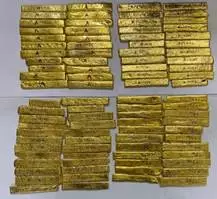

All that glitters is gold: Photo for representation
Driven by rising geoeconomic uncertainties, the Reserve Bank of India (RBI) along with other central banks have embarked on a gold rush. India’s gold reserves, which were less than 600 tonnes 10 years ago, have now risen to 795 tonnes. Many countries are looking at de-dollarisation as a more permanent solution especially with the looming US debt default risk. That apart, with rising inflation in the US the real interest rate on US government bonds has turned negative. These could further push the demand for the yellow metal.
Typically, the value of the yellow metal rises when the US dollar falls in value. This also provides the required cushion against volatility.
“There is a risk when we use financial sanctions that are linked to the role of the dollar that over time it could undermine the hegemony of the dollar,” US Treasury Secretary Janet Yellen told CNN last month.
The American lawmakers are yet to reach a consensus on the issue of debt ceiling.
If the US debt ceiling – the maximum amount that a country can borrow — is not increased immediately, the US could actually default.
Central banks across the world are now aggressively looking to diversify their foreign exchange reserves as US led sanctions on Russia have pushed countries to look at alternative payment systems while reducing dependence on the American dollar. The ongoing US debt crisis is further leading to erosion of the currency, which accounts for about $6.6 trillion of daily trade.
In 2022, the net purchase of the yellow metal by the central banks stood at 1135 tonnes—the highest since 1967. Turkey, China and Egypt were the top three buyers of gold. India added 33 tonnes and was placed sixth on the chart. Central bank net purchases totalled 463 tonnes in 2021, according to Gold Hub. This marks a significant rebound in demand from this sector following the decade low of 255 tonnes in 2020, it added.
Russia and China, the topmost geopolitical rival so the US have been most aggressive with gold buying. Moscow, in particular, accelerated its gold purchases after being hit by Western sanctions following its annexation of Crimea in 2014, Mining.com said.
The increase in gold reserves for countries have risen dramatically since the outbreak of Covid 19 pandemic. In July 2020 India’s gold reserves were at 661.4 tonnes. Since then, the Reserve Bank of India has increased the bullion reserves. “The drastic shift in world politics is driving economy. Central banks, therefore, are now switching gears,” a senior official at a state owned bank, who is in charge of treasury told India Narrative.
Also read: Why de-dollarisation is shaking up the global financial system
Minister for Electronics and Information Technology Ashwini Vaishnaw said on Friday that the government is…
Renowned human rights activist and political analyst Amjad Ayub Mirza has expressed a strong denunciation…
As was widely expected, the Indian economy grew by 6.5 per cent in real terms…
World No Tobacco Day, marked annually on 31 May, addresses a major public health challenge--the…
Defence Minister Rajnath Singh, addressing officers and sailors onboard India's first indigenous aircraft carrier INS…
The leadership team from the Central Tibetan Administration (CTA) arrived in Tokyo to participate in…